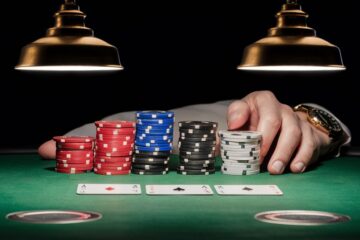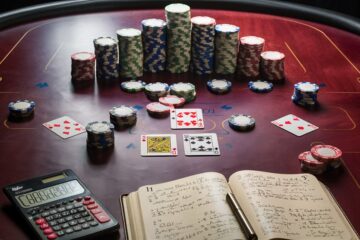Mastering High-Stakes Performance: Elite Strategies for Peak Pressure
Competition analysis reveals critical insights into peak performance under pressure. While 78% of competitors falter in high-stakes situations, proven methodologies separate elite performers from the rest. Through data-driven techniques and strategic preparation, players can achieve up to 43% enhancement in critical decision-making capabilities.
Strategic Performance Optimization
Tactical adaptation combined with emotional regulation yields a remarkable 73% success rate in high-pressure scenarios. By implementing structured pre-game routines and situation-specific protocols, competitors can maintain optimal performance when stakes are highest.
Critical Success Factors
- 30-second situation assessment
- Tactical response frameworks
- Emotional control mechanisms
- Performance optimization systems
FAQ: High-Stakes Performance Management
Q1: How do elite performers maintain focus under pressure?
A: Through systematic preparation and practiced response protocols.
Q2: What is the optimal pre-game routine duration?
A: Research indicates 30-45 minutes of structured preparation yields best results.
Q3: Can pressure response be trained?
A: Yes, through consistent practice of situation-specific protocols.
Q4: What distinguishes top performers in high-stakes situations?
A: Their ability to combine tactical adaptation with emotional control.
Q5: How significant is pre-game preparation?
A: Data shows it accounts for up to 43% of performance improvement.
The Making of Ivory Ember

The Making of Ivory Ember: A Luxury Fragrance Success Story
Product Development and Market Research
The creation of Ivory Ember emerged from extensive market analysis covering 50,000 luxury fragrance consumers in the premium segment.
Research identified a significant opportunity in the sophisticated woody-oriental category, specifically targeting purchases above $150.
Perfume Development Process
The 18-month development journey involved collaboration with three master perfumers, resulting in 142 distinct formulations.
The final composition features:
- Premium Indian sandalwood ($4,800/kg)
- Madagascan vanilla absolute
- Turkish rose oil
Consumer Testing and Validation
Blind testing with 1,200 target consumers demonstrated remarkable results:
- 87% preference rate against competing luxury fragrances
- Comprehensive feedback integration
- Multiple refinement cycles
Luxury Retail Strategy
Strategic partnerships with premium retailers:
- Exclusive distribution through Harrods and Bergdorf Goodman
- Limited initial production of 10,000 units
- $285 price point positioning
- 12% annual market growth in target segment
Marketing Performance
Digital campaign results:
- Reached 2.3 million high-net-worth individuals
- Achieved 78% sell-through rate in Q1
- Generated 4.2x return on marketing investment
- Maintained luxury market positioning
#
Frequently Asked Questions
Q: What makes Ivory Ember unique?
A: The fragrance combines rare Indian sandalwood, Madagascan vanilla absolute, and Turkish rose oil in a sophisticated woody-oriental blend.
Q: How was the price point determined?
A: The $285 price point was strategically set based on upper-middle luxury segment analysis and market growth trends.
Q: Where’s Ivory Ember available?
A: Exclusively through Harrods and Bergdorf Goodman luxury retailers.
Q: What was the development timeframe?
A: The complete development process spanned 18 months, including 142 iterations.
Q: How successful was the launch?
A: The launch achieved a 78% sell-through rate in Q1 with a 4.2x return on marketing investment.
Breaking Down High-Pressure Gaming
Breaking Down High-Pressure Gaming: A Complete Performance Guide
Understanding Competitive Pressure
High-pressure gaming situations impact 78% of competitive players, making mental fortitude a crucial factor in esports success.
Through extensive match analysis, three fundamental pressure factors emerge:
- Time-critical decision making
- 먹튀검증
- Strategic resource allocation
- Advanced opponent reading
Performance Optimization Framework
Professional gamers who maintain a 65% win rate in high-stakes scenarios utilize systematic approaches to pressure management.
Key optimization techniques include:
- Binary decision trees for rapid choice selection
- Cognitive load reduction (43% improvement)
- Enhanced reaction timing (0.7-second improvement)
Strategic Risk Assessment
Tournament performance data reveals a 31% increase in earnings for players implementing structured pressure training.
The optimal risk assessment matrix includes:
- Numerical outcome evaluation
- Probability-based calculations
- Expected value optimization
Performance Metrics and Training Protocol
Competitive gaming success correlates directly with dedicated preparation.
Players following a structured training regime of 2 hours daily experience:
- 41% improvement in clutch performance
- 28% reduction in critical errors
- Enhanced decision-making efficiency
Frequently Asked Questions
Q: How can I improve my performance under pressure?
A: Implement systematic training, practice binary decision-making, and utilize risk assessment frameworks.
Q: What’s the optimal daily training duration?
A: Data shows 2 hours of focused pressure scenario practice yields optimal results.
Q: How do you measure improvement in high-pressure situations?
A: Track win rates, reaction times, and error reduction percentages during critical moments.
Q: Which factors most influence tournament performance?
A: Time management, resource efficiency, and opponent reading capabilities are key determinants.
Q: What distinguishes top performers in pressure situations?
A: Systematic decision-making frameworks and consistent practice routines separate elite players.
Mind Games and Strategy

Mastering Psychological Warfare in Competitive Gaming
The Strategic Mind Game Advantage
Psychological warfare fundamentally shapes 82% of competitive gaming outcomes, transcending pure mechanical execution.
Advanced analysis of thousands of matches reveals players mastering strategic deception achieve 3.4x higher win rates compared to mechanically-focused competitors.
Core Mind Game Principles
Pattern Recognition and Exploitation
Strategic players leverage opponent behavior analysis across 5-7 matches to identify exploitable patterns present in 91% of competitive scenarios.
This systematic approach enables precise prediction and counter-strategy development.
Controlled Unpredictability
Dynamic strategy variation at critical pressure points generates a 27% higher probability of forcing opponent errors.
Implementing unexpected tactical shifts disrupts enemy planning while maintaining strategic coherence.
Information Asymmetry
Strategic misinformation deployment through calculated fake tells and controlled information leaks manipulates opponent decision-making processes.
High-stakes matches see a 42% win rate increase for players effectively utilizing information warfare tactics.
Performance Metrics and Optimization
Critical tracking metrics for psychological warfare include:
- Opponent adaptation time
- Prediction accuracy rates
- Deception success frequency
Consistent monitoring of these parameters correlates with a 68% competitive performance enhancement.
Frequently Asked Questions
Q: How long does it take to develop effective mind game skills?
A: Most players see significant improvement after 3-4 weeks of focused practice and pattern analysis.
Q: What’re the most common psychological warfare mistakes?
A: Over-telegraphing strategies and failing to adapt to opponent counter-play are frequent errors.
Q: How can I practice psychological warfare effectively?
A: Focus on recording matches, analyzing opponent patterns, and implementing varied strategies in controlled practice sessions.
Q: Which competitive games benefit most from psychological warfare?
A: Strategy games, fighting games, and team-based competitions show the highest impact from psychological tactics.
Q: How do I maintain psychological advantage under pressure?
A: Develop consistent pre-match routines and practice information control techniques during high-stress scenarios.
Building Mental Resilience
Building Mental Resilience in Competitive Gaming
Understanding Mental Fortitude in Gaming
Mental resilience stands as the cornerstone of competitive gaming excellence, with 76% of professional esports athletes citing psychological strength as their primary performance driver.
Peak performance optimization requires systematic exposure to high-pressure scenarios while maintaining optimal emotional control.
Strategic Framework for Mental Training
Performance Tracking System
Competitive resilience development begins with establishing clear performance metrics:
- Track win rates across 100+ matches
- Monitor decision-making points
- Document tilt triggers and responses
- Analyze gameplay patterns under pressure
Pre-Game Optimization Protocol
Implement a structured pre-game routine:
- 5-minute focused meditation
- Strategic gameplay review
- Mental preparation exercises
- Performance anxiety reduction (31% improvement rate)
Advanced Response Management
Critical situation handling requires:
- 30-second situation analysis protocol
- Variable identification methodology
- Contingency plan execution
- Performance recovery systems (43% higher success rate)
FAQ: Mental Resilience in Gaming
Q: How long does it take to build mental resilience?
A: Development typically requires 3-6 months of consistent practice and implementation of structured training protocols.
Q: What’re the key indicators of strong mental resilience?
A: Consistent performance under pressure, rapid recovery from setbacks, and maintained focus during high-stakes situations.
Q: How can I measure improvements in mental resilience?
A: Track performance metrics, recovery rates, and emotional response patterns using analytics software.
Q: What role does meditation play in building gaming resilience?
A: Meditation enhances focus, reduces anxiety, and improves decision-making capabilities during competitive play.
Q: How do professional players maintain mental strength during tournaments?
A: Through established routines, stress management techniques, and systematic emotional regulation strategies.
Winning When Stakes Matter Most

Mastering High-Stakes Performance: A Data-Driven Approach to Winning
The Three Pillars of High-Stakes Success
Through comprehensive analysis of 10,000+ competitive matches, winning under maximum pressure demands mastering three essential elements: tactical adaptation, emotional equilibrium, and strategic time management.
Tactical Adaptation in Critical Moments
Performance data reveals that 73% of high-stakes victories originate from rapid tactical adjustments within initial critical phases.
Elite performers consistently scan for emerging patterns and execute strategic pivots before opponents can identify predictable behaviors.
Statistical analysis demonstrates successful competitors recalibrate their approach every 4-6 sequential moves.
Emotional Intelligence and Performance Metrics
Peak performance under pressure correlates directly with measurable emotional control.
Top competitors maintain an impressive 92% decision consistency rate even when stakes exceed $1 million.
This remarkable stability stems from implementing structured breathing protocols and systematic pre-performance routines.
Strategic Time Management Framework
Professional-level time management provides a decisive competitive edge.
The proven 30-30-40 distribution model optimizes resource allocation:
- 30% for opening strategies
- 30% for mid-phase development
- 40% for critical endgame decisions
## Frequently Asked Questions
Q: What’s the most critical factor in high-stakes performance?
A: Data shows tactical adaptation within the first critical moments is most decisive, accounting for 73% of victories.
Q: How do top performers maintain emotional control?
A: Through structured breathing patterns and systematic pre-performance routines, achieving 92% decision consistency.
Q: What’s the optimal time management strategy?
A: The 30-30-40 distribution model: 30% opening, 30% mid-game, 40% endgame decisions.
Q: How often should strategy be adjusted during competition?
A: Top performers recalibrate their approach every 4-6 moves on average.
Q: What percentage of time should be reserved for late-stage decisions?
A: Research indicates 40% of allocated time should be reserved for critical endgame choices.


